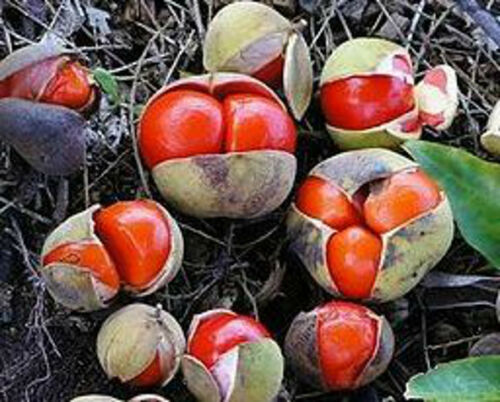
These trees when standing next to them are around 5ft to 6ft tall. Because of their size, courier or pickup only. I can send you pics if you want.

Description
A large straight tree to 30 m tall. It has greyish-brown bark with vertical cracks. New leaves are at first softly-hairy, but soon become more or less hairless. The leaves are 10 – 35 cm long and are divided into four to eight leaflets. Small clusters of greenish-white flowers are borne amongst the leaves. The fruits are creamy-brown and in crowded clusters about 10 cm long. The capsules, usually three-lobed, enclose one seed per lobe. Each seed is surrounded by yellow or deep pinkish-red flesh.

Distribution
Recorded from the coastal lowlands between Richmond River on the Far North Coast of NSW and Mudgeeraba Creek on the Gold Coast hinterland, Queensland.

Habitat and ecology
- Confined to the warm subtropical rainforests of the NSW-Queensland border lowlands and adjacent low ranges.
- The forest types in which the species occurs vary from lowland subtropical rainforest to drier subtropical rainforest with a Brush Box open overstorey.
- Occurs on basalt-derived soils and also on poorer soils such as those derived from quartz monzonite.
- Flowering times vary across its range depending on latitude and to some extent annual seasonal variations.
- Ripe fruits are generally present from January to early April, with peak fruiting during the last week of February and early March.
- Seed dispersal mechanisms are unclear.

Diploglottis campbellii
From Wikipedia, the free encyclopedia
| Diploglottis campbellii | |
|---|---|
| Diploglottis campbellii juvenile leaf | |
| Conservation status | |
 Endangered (EPBC Act) | |
| Scientific classification | |
| Kingdom: | Plantae |
| Clade: | Tracheophytes |
| Clade: | Angiosperms |
| Clade: | Eudicots |
| Clade: | Rosids |
| Order: | Sapindales |
| Family: | Sapindaceae |
| Genus: | Diploglottis |
| Species: | D. campbellii |
| Binomial name | |
| Diploglottis campbellii Cheel. |

Diploglottis campbellii is a rainforest tree northern New South Wales and southeastern Queensland. Growing to 30 metres tall, it is commonly known as the small-leaved tamarind. It is rare and threatened and is restricted to a small number of sites, each with a maximum of 3 trees per site. However, it is readily available from nurseries in the Northern Rivers area of New South Wales, and in south-eastern Queensland.

It has soft hairy new growth that becomes hairless with age. It has a grey brown trunk, the outer surface of live bark is green with orange to brown blotches, leaves 10–35 cm long, leaflets 4–8 cm, glossy upper surface, pale dull bottom surface

The inflorescence type is a panicle up to 15 centimetres long with small creamy brown flowers, Fruit usually 2 lobed but can be 1 or 3 lobed (each lobe holding a single seed), hairless, Red (rarely yellow) with a brown capsule, ripe Feb- April.

Uses
The fruit of small-leaved tamarind is edible, and has a piquant flavour. It is used in sauces and preserves. Because the tree is very rare in the wild availability of fruit was a limitation for many years. However, increased planting of small-leaved tamarind has resulted in larger volumes of fruit becoming available for food, as well as ensuring the survival of this species.

The plant has proved adaptable in cultivation, being used in amenity horticulture and bushfood plantings. It is extensively planted in Lismore.NSW Australia
Any questions or if buying, contact me HERE


